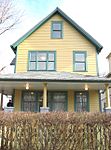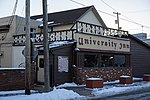St. Theodosius Russian Orthodox Cathedral

St. Theodosius Cathedral (Russian: Собор Святого Феодосия) is an Eastern Orthodox church located on Starkweather Avenue in the near west side neighborhood of Tremont in Cleveland, Ohio. Considered one of the finest examples of Russian church architecture in the United States, it is listed on the National Register of Historic Places. St. Theodosius was the first Eastern Orthodox parish in Cleveland and is currently under the jurisdiction of the Diocese of the Midwest of the Orthodox Church in America. The cathedral is perhaps best known for its appearance in the 1978 Best Picture-winning film, The Deer Hunter, with Robert De Niro, Christopher Walken, and Meryl Streep. It is also seen in the opening credits of Major League.
Excerpt from the Wikipedia article St. Theodosius Russian Orthodox Cathedral (License: CC BY-SA 3.0, Authors, Images).St. Theodosius Russian Orthodox Cathedral
Starkweather Avenue, Cleveland
Geographical coordinates (GPS) Address External links Nearby Places Show on map
Geographical coordinates (GPS)
| Latitude | Longitude |
|---|---|
| N 41.477222222222 ° | E -81.681666666667 ° |
Address
Saint Theodosius Russian Orthodox Cathedral
Starkweather Avenue
44113 Cleveland
Ohio, United States
Open on Google Maps






